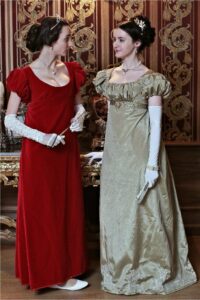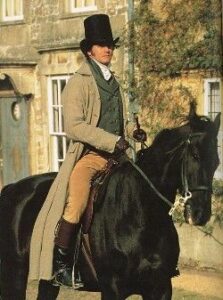Regency Era Fashion, reflected the beauty and refinement of the period. This era was characterized by the influence of the English Regency style, marked by simplicity and classical elements inspired by ancient Greece and Rome. Women’s fashion during this time featured high-waisted dresses with empire silhouettes, also with the highlight of a natural waistline and flowing skirts. These dresses were often made of lightweight fabrics like muslin and adorned with delicate details such as embroidery and lace. Men’s fashion was characterized by tailored coats, waistcoats, and trousers, often made of fine wool or silk fabrics. The Regency era’s fashion aesthetic was defined by its graceful lines, understated elegance, and a departure from the elaborate styles of the preceding Georgian era.
Table of Content:-
- Evolution of Regency Era Fashion
- Women’s Fashion in the Era of Regency
- Men’s Fashion in the Era of Regency
- Hairstyles and Headwear in that Era
- Social Influences on Regency Era Fashion
- Legacy of Regency Era Fashion

regency-era-fashion
Evolution of Regency Era Fashion
Early Regency Fashion
At the beginning of the Regency era, fashion retained some elements of the late Georgian period, such as full skirts and complex decorational ornaments. Women’s dresses featured high waistlines, often just below the bust, creating an empire silhouette. Fabrics like lightweight muslin were popular, reflecting a desire for simplicity and comfort. Men’s fashion included tailored coats with high collars and fitted waistcoats, showcasing a transition towards a more streamlined and refined aesthetic.
Mid-Regency Fashion
During the mid-Regency period, fashion underwent significant changes influenced by societal shifts and cultural trends. Women’s dresses became more prolonged, with skirts gradually slimming down and waistlines lowering slightly. Empire silhouettes remained popular, but dresses began to feature more complex details. Men’s fashion continued to evolve with coats becoming more fitted and trousers becoming narrower.
Late Regency Fashion
Towards the end of the Regency era, fashion trends began to foreshadow the styles of the upcoming Victorian period. Women’s dresses adopted a more defined waistline, transitioning from the high empire silhouette to a slightly lower waist. Skirts became fuller again, with the introduction of padded hems and petticoats. Fabrics like silk and satin gained popularity, adding a luxurious touch to women’s attire. Men’s fashion saw the rise of the frock coat, a longer and more tailored alternative to the previous styles, marking a departure from the earlier Regency aesthetic.
Legacy of Regency Fashion
The fashion of the Regency era left a lasting legacy, influencing subsequent periods and contemporary styles. Elements like the empire silhouette, lightweight fabrics, and refined tailoring continued to inspire fashion designers in the Victorian era and beyond. The focus on simplicity, beauty, and classical influences established during the Regency period remains relevant in modern fashion, showcasing the enduring appeal of this distinctive era in sartorial history.
Women’s Fashion in the Era of Regency
Empire Silhouette
Women’s fashion during the Regency era was characterized by the empire silhouette, featuring high waistlines that sat just below the bust. Dresses had a loose and flowing fit, with skirts that fell gracefully to the floor. This silhouette emphasized a natural and slender figure, reflecting the influence of classical Greek and Roman fashion ideals.
Lightweight Fabrics
Dresses in the Regency era were typically made of lightweight fabrics like muslin, cotton, and silk. These materials were chosen for their softness and drape, allowing for comfortable wear and ease of movement. Pastel colors and delicate prints were favored, adding a touch of femininity to the garments.
Simple Yet Rare Designs
Regency-era dresses were known for their simplicity yet rare. They often featured less decorative, with focuses on the cut and silhouette of the garment. Necklines were typically high and modest, with short sleeves or sleeveless designs. Dresses were sometimes adorned with subtle details like ruffles or lace trims, to add a touch of culture.
Empire Waistline Dresses and Accessories
Women’s attire was complemented by accessories such as shawls, gloves, and delicate jewelry like pearl necklaces and earrings. Bonnets were popular headwear, often adorned with ribbons and flowers. Women also carried reticules, small handbags used to hold essentials like fans, handkerchiefs, and smelling salts. These accessories added both practicality and refinement to the overall ensemble, completing the Regency-era look.

regency-era-fashion-women’s
Men’s Fashion in the Era of Regency
Tailored Coats and Jackets
Men’s fashion during the Regency era featured tailored coats and jackets that makes a slender and attractive silhouette. Coats were typically cut with high collars and narrow lapels, often reaching to the knees. These garments were made from fine wool or silk fabrics and were designed to fit closely to the body, reflecting the era’s preference for refined and tailored attire.
Waistcoats and Shirts
Waistcoats, or vests, were essential elements of men’s fashion in the Regency era. These sleeveless garments were worn over shirts and beneath coats, adding both warmth and style. Shirts were typically made of linen or cotton and featured high collars and long sleeves. They were often paired with cravats, or neckcloths, which were tied around the neck in complex knots for a culture look.
Hairstyles and Headwear
Men’s hairstyles during the Regency era were typically short and neat, with hair worn close to the head and styled with pomade or powder. Sideburns were fashionable, and some men sported small curls at the temples. Headwear included tall top hats made of felt or beaver fur, which were worn for formal occasions. For more casual wear, men opted for caps or hats made of cloth or straw, providing both style and protection from the elements.

regency-era-fashion-men’s
Hairstyles and Headwear in that Era
Women’s Hairstyles
Women’s hairstyles in the Regency era were often simple and beautiful. Hair was typically worn up in soft curls or twisted into complex, with loose tendrils framing the face. Hair accessories like ribbons, combs, and feathers were popular for adding decorative touches to hairstyles. Bonnets were the most common form of headwear, covering the hair completely and often adorned with ribbons, flowers, or lace trimmings.
Men’s Hairstyles
Men’s hairstyles during the Regency era were generally short and neatly groomed. Hair was typically combed back from the forehead and sides, with a slight wave or curl at the front. Sideburns were fashionable, often extending down to the jawline. Some men also sported small curls or ringlets at the temples. Hair had styled with pomade or powder to achieve a sleek and polished look.
Bonnets for Women
Bonnets were essential accessories for women in the Regency era, worn outdoors to protect the hair and face from the sun and weather. These head coverings featured a brim that framed the face and tied under the chin with ribbons or strings. Bonnets came in various styles and materials, from simple straw designs for everyday wear to more detailed silk or satin creations for formal occasions.
Top Hats and Caps for Men
Top hats were the iconic headwear for men during the Regency era, worn for formal events and occasions. These tall, cylindrical hats had made of felt or beaver fur and featured a flat crown and narrow brim. For more casual wear, men opted for caps or hats made of cloth or straw, such as the flat cap or the boater hat. These headwear options provided both style and practicality for different occasions.

regency-era-fashion
Social Influences on Regency Era Fashion
Impact of Cultural Trends
Cultural trends, including the Romantic movement and a growing interest in classical antiquity, influenced Regency era fashion. The Romantic movement makes individualism, emotion, and nature, leading to a preference for soft and flowing fabrics, sensitive details, and natural matters in clothing design. Interest in classical antiquity inspired fashionistas to draw inspiration from ancient Greek and Roman styles, resulting in garments with empire silhouettes, draped fabrics, and classical content such as laurel wreaths and Greek key patterns.
Social Class Distinctions
Social class distinctions played a significant role in shaping Regency era fashion, with clothing styles often reflecting one’s social standing and wealth. The upper class favored luxurious fabrics, complex decoration of ornaments, and fashionable accessories to showcase their status and refinement. Middle-class individuals sought to emulate upper-class fashion trends within their means, while the working class prioritized practicality and durability in their clothing choices. These social distinctions influenced everything from the choice of fabrics and designs to the types of accessories worn.
Influence of Cultural Icons and Influencers
Cultural icons and influencers, such as royalty, celebrities, and fashion trendsetters, had a profound impact on Regency era fashion. The style preferences of prominent figures like Queen Charlotte and Beau Brummell set trends and influenced the tastes of society at large. Fashion plates and publications disseminated the latest styles and trends, allowing individuals to emulate the looks of their favorite cultural icons. These influencers played a crucial role in shaping the evolving fashion landscape of the Regency era, dictating which considered fashionable and desirable within society.
Legacy of Regency Era Fashion
Historical activities and Events
Regency era fashion remains popular in historical gatherings, costume events, and themed parties. Addict recreate the iconic looks of the period, paying homage to its refined aesthetics and cultural significance. These events help preserve the legacy of Regency fashion and allow people to experience the glamour and romance of the era first hand.
Literary and Cinematic Influence
The portrayal of Regency era fashion in literature and film has contributed to its enduring legacy. Works like Jane Austen’s novels and film adaptations set in the Regency period showcase the era’s distinctive clothing styles, further embedding them in popular culture and inspiring audiences around the world.
Fashion Museums and Exhibitions
Fashion museums and exhibitions feature collections of Regency era garments, highlighting their historical importance and artistic craftsmanship. These displays educate visitors about the evolution of fashion and the societal influences that shaped clothing styles during the Regency period. By showcasing these artifacts, museums help preserve the legacy of Regency fashion for future generations to appreciate and learn from.
Frequently Asked Questions:-
What did people wear during the Regency era?
During the Regency era, women wore high-waisted dresses with flowing skirts, often made of lightweight fabrics like muslin. Men wore tailored coats and trousers, paired with waistcoats and cravats, reflecting a refined and attractive style.
Why were bonnets popular in Regency fashion?
Bonnets were popular headwear in Regency fashion because they provided both style and protection from the sun and weather. They covered the hair completely and had often adorned with ribbons and flowers, adding a feminine touch to the overall ensemble.
How did Regency fashion change from the Georgian era?
Regency fashion differed from the Georgian era with its values on simplicity and classical influences. Clothing styles became lighter and more comfortable, with a move towards natural waistlines and softer silhouettes.
Who influenced Regency fashion trends?
Influential figures like Beau Brummell, known for his perfect taste and grooming, and cultural icons like Queen Charlotte played significant roles in shaping Regency fashion trends. Their preferences and style choices set the tone for fashionable attire during the era.
What is the legacy of Regency fashion today?
The legacy of Regency fashion lives on through its continued influence on modern trends, its portrayal in literature and film, and its popularity in historical gatherings and themed events. Regency-era garments had preserved in fashion museums, showcasing their historical importance and artistic craftsmanship for future generations to appreciate.
Conclusion
Regency era fashion can characterized by its beauty, simplicity, and classical influences. From the high-waisted dresses of women to the tailored coats of men, clothing styles reflected a departure from the complex fashions of the Georgian era. Bonnets and top hats were popular accessories, adding both style and practicality to outfits. Influential figures like Beau Brummell and Queen Charlotte played key roles in shaping fashion trends of the time. Today, the legacy of Regency fashion lives on through its continued influence on modern trends, its portrayal in literature and film, and its preservation in fashion museums and historical events.
source by:- https://images.app.goo.gl/Q22Ra9aBfXVJYco96 , https://images.app.goo.gl/AmYNdCWvhCT1tJV2A , https://images.app.goo.gl/9wwTFix2rvj1agFJ6 , https://images.app.goo.gl/d56gB34os1nY5M7ZA
written by :-https://bioleather.in/
